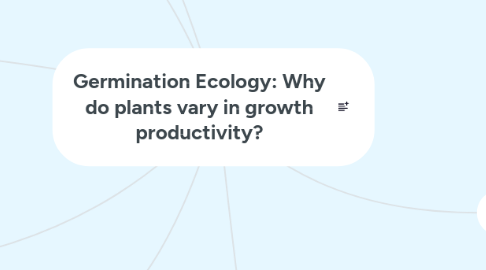
1. Intraspecies cooperation: growing together facilitates and promotes growth (*Note: do some reading on this!)
1.1. Cooperation must increase fitness- How?
1.1.1. Does cooperation facilitate resource use?
2. Intraspecies Competition
2.1. plants of the same species competing with each other for resources
2.1.1. How does the degree of competition vary amongst species?
2.2. Corn
2.3. Pea
2.4. Other?
2.5. How does competition differ with varying plant density (the 8 pots vs. the 2 pots)
2.5.1. In the pilot experiment the 8 seed pots are growing taller than the 2 seed pots
2.5.1.1. Does competition enhance growth?
2.5.1.2. connects to "always compete" branch
3. Interspecies Competition?
3.1. plants of DIFFERENT species competing against each other for resources
3.1.1. Does one species appear to be a stronger competitor? (i.e., does one appear to dominate the other + exhibit more growth?)
3.1.1.1. INTRASPECIES: does germination order matter? Do those that germinate earlier appear to be the strongest competitors?
4. Temperature?
5. Do plants ALWAYS compete with one another?
5.1. **EXPERIMENT**:
5.1.1. At excessively high seed density, growth is hindered rather than promoted due to competition; plants germinated at 16 seeds will have smaller leaf area Germination order impacts growth; plants that germinate earlier will outcompete others and have a greater leaf area than those that germinate later
5.1.2. EXPLANATORY VARIABLE: seed density at planting Experimental treatments: 8 and 16 peas Control treatment: 8 pea pots (based on pilot experiment…)
5.1.3. RESPONSE VARIBALE:Average leaf size (proxy for growth productivity)
5.1.4. A single replicate will be a pot with its given number of seeds (8 or 16) There will be 8 replicated per treatments, The sample size will be 16 pots.
6. Limiting Factors
6.1. Water, nutrients, space, light
6.1.1. nutrients
6.1.1.1. nitrogen- affects plant leaf development
6.1.1.1.1. Too much nitrogen can cause stability issues
6.1.1.1.2. Some fertilizers use a “quick release” formulation that allow for fast greening, but provide for no long term health
6.1.1.2. phosphorus- assists growth of roots and flowers
6.1.1.2.1. excesses of phosphorus have several undesirable effects interfere with a plant’s absorption of iron, manganese and zinc, resulting in yellowing of leaves and poor health of the plant
6.1.1.3. potassium- contributes to early growth and help retain water
6.1.2. Water
6.1.2.1. Water is essential for the transportation of the above nutrients throughout the plant.
6.1.2.2. Water also allows plants to stand without it they will droop.
6.1.2.3. Water is ESSENTIAL for plant growth: required for photosynthesis AND cellular respiration -- without water plants can't survive
6.1.3. Space
6.1.3.1. Room for growth- above ground portion and roots
6.1.3.2. Space can limit how large a plant can grow (e.g. if something is in its way, like another plant, that is space that it cannot occupy)
6.1.3.2.1. If there is not enough space for the plants to grow will competition increase or will the plants give up and not grow?
6.1.4. Light
6.1.4.1. Light is required for photosynthesis --- ESSENTIAL for plant growth!
6.1.4.2. Since our plants our green and reflect green, will the color of light affect the growth?
6.1.4.2.1. "The purple and blue light wavelengths, 400 to 490 nanometers, stimulate the vegetative growth phase while the yellow-orange-red wavelengths are used for flowering and fruiting. "-epicgardening.com
6.1.4.2.2. **EXPERIMENT HYPOTHESIS**Does the color of light have any effect on plant growth?
6.1.4.3. Normal sunlight rhythm vs. ecology lab lamp: does it make a difference because the lamp is always on, as opposed to the day/night rhythm of natural sunlight
7. Fitness
7.1. f= f(growth, survival, reproduction)
7.1.1. "most fit" = strongest competitor, most able to attain adequate resources to survive and reproduce
7.1.1.1. In OUR experiment: proxy for fitness is growth productivity (leaf size)
